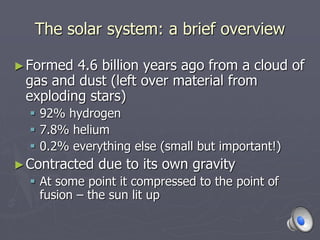
HPU NCS2200 Solar system lecture
- 1. The solar system: a brief overview ►Formed 4.6 billion years ago from a cloud of gas and dust (left over material from exploding stars) 92% hydrogen 7.8% helium 0.2% everything else (small but important!) ►Contracted due to its own gravity At some point it compressed to the point of fusion – the sun lit up
- 2. The solar system: a brief overview The part that didn’t become the Sun was a nebular cloud ►Nebula – rotating disc of gas and dust This mass of dust, etc. coalesced to form the planets As this mass collected it solidified and formed gravity which attracted more material and greater gravity. The hydrogen & helium gases were very light and for the smaller planets were able to achieve escape velocity The masses closest to the Sun were subjected to Solar Winds
- 3. p.584a
- 4. Spinning Nebula ► Planets also form from solar nebulas. ► The planets form from dust and gases at the edges of the spinning nebula. ► The dust particles collide with each other and form into larger particles. This goes on until the particles get to the size of boulders. http://www.psi.edu/projects/planets/planets.html Image credit: William K. Hartmann/PSI The Planetary Science Institute has developed a computer model to investigate these processes.
- 5. Protoplanet Forms ► These boulders collide to form larger masses called planetissimals. ► Planetissimals continue to spin developing their own gravity which allows them to draw in larger quantities of particles and smaller planetissimals and grow into protoplanets. http://www.psi.edu/projects/planets/planets.html The unfinished earth by William K. Hartmann
- 6. The solar system: a brief overview This process created four inner, rocky, terrestrial planets: Mercury, Venus, Earth & Mars and four outer, gaseous, Jovian planets: Jupiter, Saturn, Uranus and Neptune ►These were much larger and further from the Sun and thus able to hold on to the very light gases from the original nebula
- 7. Inner vs Outer Planets ► The size and make up of the planet depends on its distance from the central star. Farther from the central star planets formed as ice cores with dense gas atmospheres. They are called the Outer Planets Closer to the central star planets formed as solids with thin gas atmospheres. They are called the Inner Planets. http://nssdcftp.gsfc.nasa.gov/miscellaneous/planetary/other/inner_pla nets.jpg http://rst.gsfc.nasa.gov/Sect19/Sect19_14. html
- 8. Chapter 22 – Motions in the Heavens Earth Science and the Environment (4th ed) Thompson & Turk
- 9. 22.2 Aristotle and the Earth-centered universe ►Geocentric – Aristotle ascribed to the idea of an Earth-centered universe People have no sensation of motion so it must be the sky that moved People do not fall off the Earth, so it must not be moving No parallax shift of stars thus Earth does not move.
- 10. 22.2 Aristotle and the Earth-centered universe ►Parallax – an apparent change in position of an object based on the observers change of position ►Aristotle found no parallax shift because of the vast distances ►Aristotle practiced science based on observation Model explained motion of most heavenly bodies
- 15. 22.3 The Renaissance and the heliocentric solar system ►The geocentric system remained mainly unquestioned for 1,400 years Copernicus – Polish astronomer found Ptolemaic system too complicated Proposed a heliocentric (sun centered) model ►Accounted nicely for retrograde (backward motion) of the planets with respect to the stars Brahe & Kepler – Brahe mapped all known objects in the sky ►Kepler proposed the idea of elliptical orbits for planets
- 16. Kepler’s laws 1. “The orbit of every planet is an ellipse with the sun at a focus.” 2. “A line joining a planet and the sun sweeps out equal areas during equal intervals of time.” 3. “The square of the orbital period of a planet is directly proportional to the cube of the semi-major axis of its orbit.”
- 17. Kepler’s Laws
- 18. 22.3 The Renaissance and the heliocentric solar system Galileo – astronomer, mathematician, physicist ►Realized that the laws of nature must be understood by observation, experimentation, and analysis. ►Observed moving objects and derived the laws of motion Quantified and expanded later by Newton ►Inertia – the tendency for an object to resist a change in motion ►Thus people traveling with the Earth would realize no motion
- 19. 22.3 The Renaissance and the heliocentric solar system Galileo questioned the base of the Aristolean view – and had a serious hardware (optics) upgrade from previous astronomers ►Jupiter had 4 objects circling it As per a geocentric system, this was not possible ►Observed Venus had Moon-like “phases”, which could not be explained with the geocentric model ►His Sun-centered system did not sit well with the Catholic Church of the day - he was forced to recant
- 20. 22.3 The Renaissance and the heliocentric solar system ►Isaac Newton and the glue of the universe Invented calculus (EEEWWWW!!!) Galileo never answered why planets moved in elliptical orbits, Newton did ►A moving body moves in a straight line unless acted on by an outside force ►Planets were being acted on by an external force ►That force was gravity – the glue of the universe
- 21. The view of our solar System would be very Different if not for these Scientific discoveries!